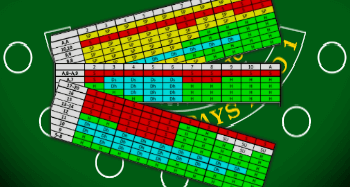Hello and welcome to this basic strategy guide to Blackjack! You're probably already familiarized with all the basics and rules of the game and since you know that decision taking is its most important aspect, you're here to learn a couple of strategies in order to play smarter. In this small guide, you will read about the most commonly used tactics you can employ which will help you establish yourself as a player.
Blackjack Strategy Terms You Need
Before you start thinking of a strategy, you need to be familiarized with a few concepts: the different types of hands you or the dealer can accumulate, under what circumstances can a dealer hit or stand as well as what the house edge is and how it affects your gameplay and odds of winning.
A Player and a Dealer's Hands
- Playing a Hard Hand– A hard hand doesn't have any aces or the aces' value is forced to count as 1 in order not to be considered a bust.
- Playing a Soft Hand – A soft hand always has at least one ace which can be worth either 1 or 11.
- Dealer Stands on All 17 – In every case that the dealer has reached 17 or more, he/she has to stand regardless if the hand is soft or not.
- Dealer Hits Soft 17 – In some casinos the dealer will stand if they have a hard 17 but will hit if they have a soft 17.
House Edge and What It Means
This term defines the percentage of profit the casino makes on average compared to the players' total sum of bets. Let's say youre playing a game with a house edge of 3.5%. That would mean that statistically speaking the casino would stand to make a profit of $3.5 and return $96.5 of the $100 you wagered. Compared to other casino games, Blackjack has the lowest house edge.
The basic strategy mentioned below lowers the house edge, depending on the number of card decks used in the game. A one deck basic strategy play would decrease the house edge to 0.17% while in the case of 8 decks, it would drop to 0,66%. Keep in mind that if the player doesnt use any tactical play or is ignorant of the rules of the game, the risk of losing money will increase.
| Top Casinos | Bonus | Regulation | Casino Type | Read More |
|---|---|---|---|---|
888casino |
$20 No Deposit Bonus |
UKGC |
Instant play
Download
Mobile
|
|
Miami Club |
$100 Deposit Bonus |
Curacao |
Instant play
Download
Mobile
|
|
Sloto Cash |
200% Match Bonus |
Curacao |
Instant play
Download
Mobile
|
|
Red Kings |
100% up to $100 |
Malta |
Instant play
Mobile
|
|
bet365 |
N/A | Gibraltar |
Instant play
Download
Mobile
|
Basic Strategy Charts and under which Conditions to Use Them
The number one thing that you must remember is that this method of playing is very dependent on the particular games' rules. You have to know the following aspects:
- How many decks there are?
- Whether the dealer stands or hits Soft 17?
- Can you double after a split?
- Is surrendering allowed?
- Does the dealer peak at the hole card for blackjack?
Once you're aware of them, you proceed towards researching the basic strategy charts which are individual for every different set of parameters. Their purpose is to lower the loss of money to the house as much as possible throughout the entire game. Mathematical predictions and odds are implemented, evaluating the player’s total point value and the dealer's up-card. This way you get a strategy with clear mapped out actions to take.
The first thing you can do is to look over only one chart which answers to the rules of the casino you want to play at. A tip that applies to all versions of this strategy is to never take insurance or even money.
Employing the Simple Blackjack Strategy

There are many people who can’t or do not wish to memorize the basic strategy. That is why another less complex chart was devised with 21 cells compared to the basic’s 250. However there are a number of incorrect variations of play in which this simpler strategy is inferior to its counterpart.
Here are some of the tips that you can follow, using this simple scheme:
In all cases:
- On hard 8 or less, hit.
- On hard 17 or more, stand.
- On soft 13 to 15, hit.
- On Soft 19 or more, stand.
- In cases of 10 or 11, double if you have more than the dealer's up card (considering a dealer's ace as 11), otherwise hit.
- Surrender 16 against 10.
- Split eights and aces
If your hand doesn't match the “In all cases” rules, and the dealer has a low 2 to 6 up-card, then play the following way:
- Double on 9.
- Stand on hard 12 or 16.
- Double on soft 16 to 18.
- Split 2's, 3's, 6's, 7's, and 9's.
If the card value isn't the same as in the seven practices above, and the dealer has a high 7 to A up-card, then hit.
How to Card Count
As time progresses, the dealer exposes every card to all players. For Blackjack that means that the cards of the past can affect the ones that come next. Based on that principle of probability, card counting becomes a very effective option for those with a quick wit.
Although there are different systems, the most effective one is the “high-low” one which consists of:
- High cards – 10, Jack, King, Queen and Ace. These are favor the player. They have a count rate of -1 because as these cards decrease in number, the player's advantage is reduced.
- Low cards – 2, 3, 4, 5 and 6. This type is better for the dealer with a count value of +1 because as their amount goes down, player advantage increases in the future.
- Neutral Cards – 7, 8 and 9. They are marked with 0 because they don't favor the house nor the player.
When you start counting the cards with their defined values above, it's useful to optimize the way you do it. While the dealer gives everybody their initial cards, you calculate how much each pair is worth (a +1 and a -1 resulting a 0 for ex.) and then as other cards come into play you sum the total worth of all hands per play. This round-for-round count is called “a running count”.
As you keep adding or subtracting every round to/from your total running count, you have to keep tabs on the number of decks remaining. This should be done to convert your running count into a “true count”. You can do this by dividing the running count by the deck count. For example, if you have a total running count of +5 and you have 2.5 decks remaining you get a true count of +2 when divided. The higher this final count is, the bigger the advantage the player will have. Depending on the case you increase and decrease your bets proportionately.
Although this tactic is not illegal as long as you're not using an external device, the casinos have the right to ban the counter from the game or in some cases the establishment.
Bankroll Management

Many novice players tend to underestimate the house's advantages when it comes to Blackjack as well as the time they play and the wagers they make. This is why having a firm hold on your bankroll is important.
The definition of a bankroll is the stack of money you set aside for betting. It is not to be confused with the money in your credit or debit card. It is vital that when you go to play blackjack at the casino, you don't take from your living expenses and always consider when to stop. While there is no universal rule to cashing out, a fair general limit would be to quit after winning 30-40% on top of your bankroll or if you lose 50% of it.
In gambling money is divided up by units, each equal to the average wager you make per game. You must know the minimum betting limit for each place or site you visit and have between 100-150 units. Other tips include using 50 units per session, playing three hours or less each time and stopping once you run out of funds.
Another way to manage your funds to always play with a fixed bet or increase and decrease your wager depending on your winning or losing streak. These ways of managing your funds are called betting systems.
Progressive and Fixed Betting Systems
In Blackjack there are two systems which players use to balance their bankroll throughout the game: the fixed and progressive.
Fixed betting is a simplistic method in which you keep wagering the same amount per hand no matter the circumstances.
The progressive systems are the type where you lower or raise your bets depending on whether you've lost or won your last hand. The main categories for this type of wagering are the “negative” and “positive” systems.
- The positive system is applied by gradually increasing your bets when you keep winning and lowering them back to the minimum when you lose. For example, if you have a $10 initial bet if you win two times in a row, you up it to 15 and increase it with $5 each consecutive time you win. In case of a loss, you go back to your original wager.
- The negative variant entails that if you lose, you bet higher to get back what you've lost.
Neither of these systems guarantee that you'll win in the long run. These strategies rely on short-term changes in success and take advantage of streaks. So whether you prefer to have your bets fixed or progressive depends on you.
You're all Set to Play
There are countless ways that professional gamblers have devised in order to improve their chances of earning money. Neither of them offers a 100% guarantee for success but if you follow these basic pieces of advice when you play at Blackjack casinos, they will give you more opportunities to win it big.
